Hello!
We wanted to bring you everything you need to know to enter this beautiful world of hydroponics. Today, Adrian, co-founder of ToDo Hydro, will tell you everything you need to start a hydroponic fruit and vegetable crop, from A to Z, in a complete summary. Make yourself a good tea or coffee and read this unique information we bring you.
Introduction
Gardening is a great activity you can choose to get involved in.
Many people love how relaxing the whole process can be and how grounding and fun it is. In addition, it’s always wonderful to enjoy fresh produce at the end of the season when it comes straight from your own garden.
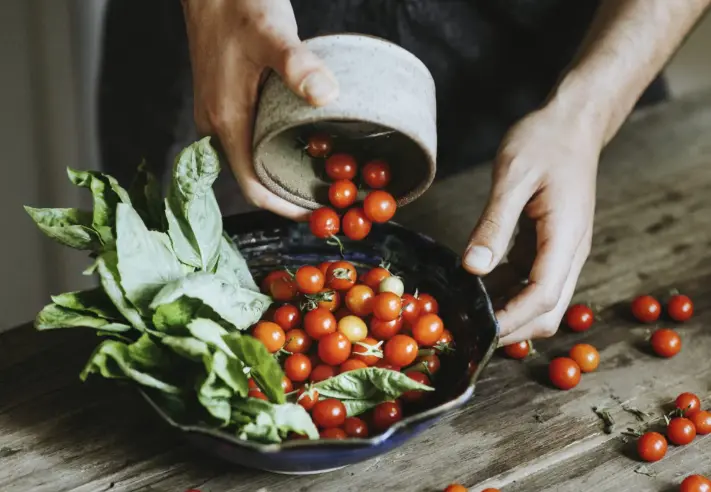
Fresh organic cherry tomato salad
However, traditional gardening is challenging. You are fighting insects, poor soil nutrients and weeds so that the plants keep growing as they should. Many people give up because it’s too hard to achieve the attractive harvest they’re looking for.
Instead of struggling with all that, consider growing a hydroponic garden to get even better results.
Hydroponic gardening does not use soil like traditional gardening. Instead, you will choose some special containers and an irrigation system to work only with water to keep the plants healthy. By adding a little nutrient solution and a pump to recirculate the water, you will be able to provide the plants everything they need without having to deal with soil and other problems that are present.
Anyone can do this process because it’s not difficult and this guide will include all the steps necessary to make it work for you. From learning more about the process, choosing the right containers, understanding the nutrients required and even ways to obtain the perfect lighting for your garden, there is nothing you can’t do with your hydroponic garden. Whether you are a beginner or have been gardening for a long time, hydroponic gardening may be the best option for you. It helps you get all the nutrients and benefits of a large, tasty garden without the hassles that come with using soil to grow plants. Read this guide and learn everything you need to know to get started with a hydroponic vegetable garden.

Vegetables hydroponics farm. Hydroponics method of growing plants
Chapter 1: What is hydroponics?
Before we go too far into this process, first we need to understand what hydroponics is.
First of all, it’s a type of gardening you can use.
While most people will start with a nice garden bed or pots to grow their plants, with plenty of soil and other things to help, hydroponics follows a different path. It recognizes that things don’t always work so well with traditional methods and that soil is not necessary to help plants grow big and strong. So hydroponics is basically a process where you distribute water, making sure to preserve quality while still providing the nutrients the plant needs to reach its full potential. Basically, this includes adding some nutrients that the plants will need to the water you supply, so soil is not important.
When you plant your produce in your garden, you rely on rain to help the process. The soil will have many of the nutrients your plants need to be strong and healthy. But plants can’t extract everything by themselves. Instead, they wait for the rain, which then releases the nutrients and delivers them to the plants. But when it doesn’t rain or you don’t water your plants yourself, you’re not only dehydrating the plants, you’re also keeping nutrients away from them.
Although this may seem like an easy process for plants to get their nutrients, it’s not perfect. There are times when it doesn’t rain enough. The soil may not have enough nutrients and plants cannot absorb more. Or maybe the nutrients are too low for the water to help. No matter the reason, this can make it very difficult to supply the plant with the nutrients it needs. Since the natural way of delivering nutrients to plants is not always as effective as we expect, hydroponics is sometimes used.
The goal of this process is to replicate the natural environment, but to make it work better. The way this is done is by adding nutrients to the water and helping it to enrich the plants in the process. When the right nutrients are in your water, the plants can absorb them and grow healthier and stronger.
If you do this process correctly, the plants can grow better than they would in your own garden or elsewhere outdoors. The nutrient solution often depends on you. Usually you will need to make a closed system to move those nutrients to the right place. Attached options are great because they can also prevent the problem of evaporation so the plants can get all the nutrients without the water evaporating. The water will always be there, you don’t have to worry about nutrients being lost to the soil or water disappearing before all nutrients are absorbed. There are several different ways to set up your hydroponics.
Organic hydroponic vegetable in the cultivation farm.
Benefits of hydroponics
At this point you can understand some of the basic concepts that come with this process, but you may be wondering why you should opt for hydroponics instead of traditional gardening…
People are used to the usual way of gardening; they set up a garden or prepare pots and make it work. The soil provides the nutrients and they just weed and water from time to time. This system has existed for years and most people have never heard of hydroponics and have no idea of all the benefits that come from doing this process.
Some benefits of choosing hydroponics instead of traditional gardening for your plants include:
Better Health – When you grow your plants hydroponically, you’re providing them with the best possible nutrient composition. You also avoid pests and weeds entering the system so plants can get everything they need without problems. Plants will grow healthier and help you achieve the best possible garden.
High Yield: It’s easy to produce a lot of food with this method. Since there are fewer pests, you’ll get more from each plant. You won’t have to work as hard to keep weeds and pests away. This is an easy way to produce food and it feeds millions of people today.
Affordable: Buying prepared soil, tilling the ground, paying for lots of water that evaporates and more will start to cost you over time. Hydroponics is actually simple and affordable, becoming one of the best ways to get a large harvest.
Less Time: You’ll find it doesn’t take much time to manage. For example, you don’t have to spend time tilling soil, watering every day and fighting weeds and pests. Make sure the plant has enough water and that nutrient levels are good, and your plants will grow.
More Productivity: Hydroponically grown plants can mature faster compared to those grown in soil. That means you can grow more harvests throughout the year for roughly the same cost.
Better for You: There’s a lot to enjoy with your new hydroponic garden. The food tastes better, is tastier and is healthier to eat. That alone makes hydroponics better to use in every sense.
As you can see, this is a great process to follow to ensure your plants are well cared for. Although it takes a bit of effort at first, it’s still an excellent process to try and even beginners can reap great benefits.
Now, let’s look at some steps you can follow to get this hydroponic system off the ground and working for your needs.

Organic hydroponic vegetable cultivation farm with. Selective focus.
Chapter 2: Choosing your hydroponic system
The first thing you should discover is the hydroponic system. This is the system that helps create the perfect conditions for your plants. It will help roots get ideal amounts of oxygen, water and nutrients, and it eliminates dehydration problems that sometimes occur with plant roots in soil and other substrates. First you’ll need to choose whether the system is passive or active. With an active system, there will be a powered device that helps circulate the nutrients your plant needs. With a passive system, you’ll rely on gravity to help keep the plants happy.
There are several different options you can choose with each of these systems and it will often depend on what works best for you. Some people prefer gravity because it requires less mechanical work, but you must manage nutrient movement. The active option works well because you can leave it running while, for example, you travel and the plants will still be cared for.
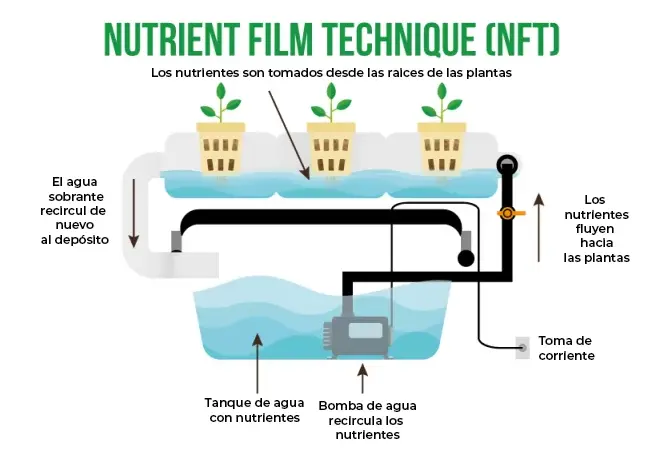
Let’s look at some of the most popular options you can choose to get the most out of your hydroponic system.
NFT (Nutrient Film Technique)
Inside this system you’ll find a channel. The plants are placed in this channel with their roots inside and they will feed on the nutrients that run through the pipes along with the water.
The nutrient solution runs through the system and contacts the plant roots. As the nutrient solution flows it is recirculated and never wasted.
A pump in this system recirculates your nutrient solution so it continuously travels through the system. It will keep circulating until you change it to add fresh nutrients. The biggest advantage of this system is that it’s completely closed. That helps create a good level of humidity that plants need to thrive.
Additionally, you reduce the risk that roots will become too dehydrated. This is also a good system for lettuce and other short-cycle crops.
Raft System (Floating System)
This is a good system for beginners because it’s affordable and efficient. Plants are placed in elevated polystyrene foam boards and float on top of a preprepared nutrient solution.
The plant roots are exposed to obtain the nutrients and water they need. The solution in the area is recirculated for oxygenation. This is another good option if you have crops that go through fast growth cycles.
DWC (Deep Water Culture)
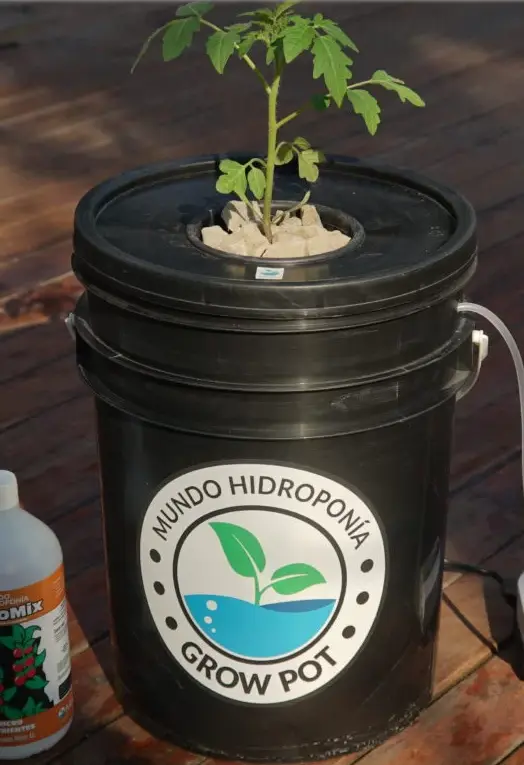
This option can be used by beginners but is usually reserved for commercial growers. It’s very effective with some of the media we discussed earlier, giving you a lot of freedom.
If you are planting a crop that takes longer to grow, like roses, basil, peppers, tomatoes and medicinal herbs like cannabis, this is the choice because it works well for those types of plants.

This system will require a PVC pipe used as a drain tube and in some cases a main water reservoir to serve as a mother tank. You’ll place your nutrient solution in a bucket; this solution is then drained through the pipes into a prepared reservoir by gravity. You’ll then set up a pump that takes the nutrient solution and pushes it back into the bucket so the cycle repeats.
This is an efficient method of irrigation and keeping your plants happy, but you must set it up correctly. This is usually reserved for commercial growers with many plants to manage at once, but if you have some experience or are ready to do the full setup, it can be a great way to care for your plants with hydroponics.
Aeroponics
Another system you can use is an aeroponic system. With this, the plants receive water and nutrients to their roots while they hang in the air.
To build this you’ll place the plants in baskets that sit over a chamber. The roots are exposed in this chamber and you can mist them with nutrient solution. This is probably one of the most efficient methods to care for your plants. The roots are the only thing you need to take care of and they only need the solution you’re using. Anything they don’t use will be recycled so you can reuse it later. You’ll need to be careful to keep the right level of humidity around the plants so they stay properly hydrated. After implementing this, you’ll see crops grow much faster compared to their soil-grown counterparts.
Choosing the correct system for your plants will take some research and depend on your personal preferences. Sometimes it has to do with the amount of space you have at home. Look at some of these options to see how easy it is to set up your own hydroponic garden without all the hassle.
Chapter 3: Plant Nutrition
Now that you have the right medium set up and a good system to help keep your plants healthy, it’s time to move on to selecting the right nutrition that will work for your plants.
The percentage of nutrients each plant needs will be made up of a combination of nitrogen, phosphorus, potassium and other elements. The plant must be able to find these minerals to grow the way you want.
Think of these elements like the nutrients your body needs. When you eat, it’s important to get the right amounts of carbohydrates, protein and fats to stay healthy. Your body extracts them from food so you can grow and stay energized.
For plants it’s the same idea. Plants usually try to extract nutrients from the soil, but when you use a hydroponic system you may need to manage the solution yourself.
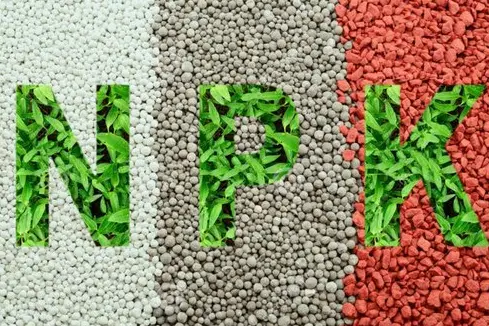
Macronutrients
To start, there are the major nutrients that all plants need to grow well. These include:
Nitrogen: Nitrogen helps create chlorophyll and amino acids which support sugar production necessary for growth.
Phosphorus: This mineral promotes flowering and fruit development.
Potassium: Potassium allows faster growth, keeps stems strong and helps defend against various diseases.
Carbon: Makes up more than 50% of the plant’s composition. Chlorophyll is the main way the plant captures this and the sugars produced by chlorophyll are important.
Hydrogen: Helps roots absorb the nutrients they need. In most cases, plants get hydrogen from the water you provide.
Oxygen: Helps the plant “breathe” so it can grow via starch and sugar production.
Without these nutrients, the plant will have serious problems growing and reproducing as it should. Always use a complete nutrient solution and be careful when mixing doses. This way you’ll have a happy, healthy plant.
Micronutrients
While macronutrients are the most important because the plant cannot grow without them, it’s also very important to include micronutrients in the regular plant nutrition.
The plant will need less of these compared to macronutrients, but adding them to the mix will help your plant flourish and look amazing. Micronutrient solutions usually contain, but are not limited to:
Calcium – Great for helping the plant create stronger cell walls. If there isn’t enough, growth may slow and other deficiencies can appear.
Sulfur – Helps the plant synthesize proteins.
Iron – Important for sugar production and chlorophyll development.
Magnesium – Helps create enzymes and chlorophyll that keep the plant strong. If deficient, leaves can yellow.
Boron – Works with calcium to produce stronger cell walls. Too little boron may result in short or brittle stems.
Manganese – Produces oxygen during photosynthesis. Lack of manganese can also cause yellowing leaves.
Zinc – Important for nitrogen metabolism, chlorophyll and respiration. Smaller leaves often indicate zinc deficiency.
Copper – Aids photosynthesis, respiration and enzyme activation. Pale yellow leaves are common when this nutrient is missing.
Making your own nutrient solution or buying a professional kit with the correct micronutrient balance can make all the difference in the growth you get each season.
Take time to check your nutrient solution to ensure you are giving your plants the best.
Selecting nutrient solutions
It’s always advisable to buy a prepared solution because it ensures correct dissolution without precipitation in your hydroponic system. This also saves time and helps you get through the process without worrying about getting the right nutrients or other problems. On the label you’ll usually see N-P-K percentages on the container or package. These are important nutrients and should make up the bulk of your solution.
This is not an area to skimp on for your hydroponic garden.
While you may want to save money later, this is the primary source of nutrients your plants will receive. They won’t find nutrients in the soil or elsewhere, so you’re responsible for getting the right solution to help your plants grow and develop properly. Always use the best nutrient solution that contains balanced, healthy nutrients and your plants will flourish.
pH levels
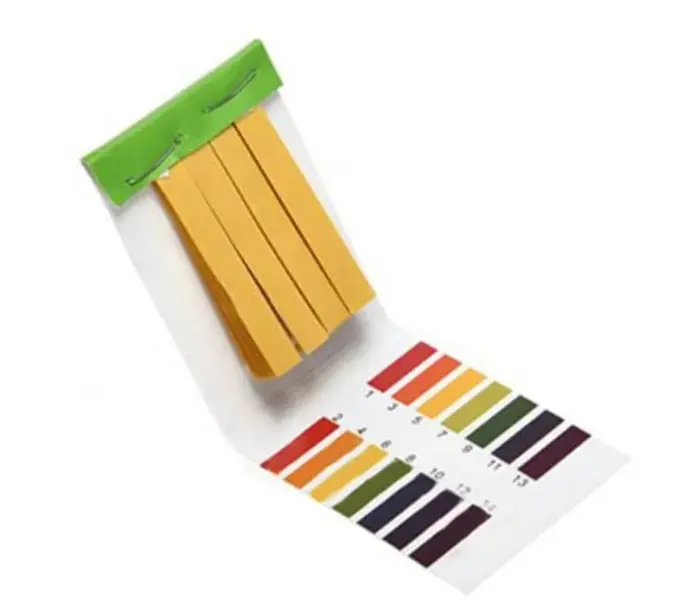
Another thing to keep in mind when it comes to your hydroponic system and plants in general is the pH level.
If those numbers are too high you may have problems with plants flowering or growing as desired. On the other hand, too acidic a pH can kill plants.
If pH drifts even slightly, plants won’t grow as well as you’d like. For most plants you should maintain pH around 5.5 to 6.5; going much below or above that range will be harmful.
Always use a good pH testing kit from time to time to ensure you are giving your plants the best environment to grow.
Using pH up and down regulators can fix the problem quickly and easily. The regulation process involves applying a few drops of these solutions to your hydroponic system; pH will be adjusted according to your needs and you can verify with pH test strips or a digital pH meter.
Chapter 4: The Right Lighting
The lighting you use for your hydroponic garden is another important aspect to consider.
Light plays an important role in helping your plant grow, so include good light sources to help the plants. However, you cannot simply use any type of light; light quality is important to help your plants grow big and strong.
The best thing you can do is place your setup in partial direct sunlight. If that’s not possible, it’s advisable to place the system in an area that gets at least morning direct sun and indirect afternoon sun, or just ambient light. This is important because seedlings or small transplants cannot tolerate direct sun all day. If not, they should be in brighter, indirect light.
If you want, you can create an indoor growing environment; this method is called “Indoor.” In this method, artificial lighting replaces the sun, providing light to maintain growth and proper temperatures.
For most indoor hydroponic gardens, sodium lamps or LEDs are used. These are good at mimicking natural sunlight and are more efficient compared to some other grow lights. These lights are designed to maximize photosynthesis and are generally affordable for most people.
To get the most out of photosynthesis, you’ll need to provide the right color spectrum, duration and light intensity. In most cases, with sodium lamps you’ll need 200 to 500 watts per square meter of growing area, depending on the number of plants and the type of crop you are growing. With new technology, LED lamps and fixtures can provide equivalent light output at lower energy consumption, though this depends on the lamp model used in your space. It’s always a good idea to test with fast-growing plants like arugula or lettuce under the lights you plan to use, and see how the plants respond.
I emphasize, this can vary depending on how much sun each plant depends on. Some will need a lot of light and you’ll need a higher wattage/brightness. Other plants don’t like as much sun and can do fine with less added lighting or lower wattage.
When you choose a sodium lamp, there will be a power rating on each lamp you choose. This will change depending on the distance you need to keep the lamp from the plants. Each power level you choose will change how close you can place the lamp to your plants for best results. Not only the type of lighting matters, but it’s a good idea to consider changing the paint of the room where you’re growing or building a grow tent you can paint or line the walls of.
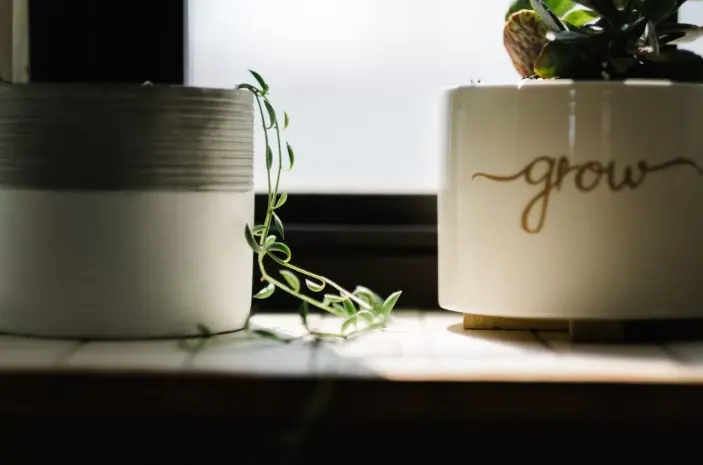
high pressure sodium lamp HPS orange light, close-up view
Many hydroponic growers like to use a bright white finish on the walls because it helps increase the amount of light that reaches the plants.
You can also get a portable light meter. Use this on your plants to check if the entire indoor garden area is evenly lit.
Each plant you grow will have different light requirements. Some need more light and others will be fine with just a few hours.
Most fruiting or flowering plants need 16 to 18 hours of light per day. Plants like lettuce or short-cycle vegetables can be grown with about half that.
You need to check how much light your specific plants require to ensure they can grow properly. Then, when buying a lamp, figure out what spectrum it emits. The color spectrum greatly impacts the amount of photosynthesis the plant can perform. Each plant needs a different spectrum. For example, when growing leafy plants, a blue spectrum light is better. For fruiting and flowering plants, a warmer, more yellowish light is recommended.
Things to keep in mind
Before you start your garden, there are a few things to remember. These are essential if you want to see impressive results from your garden and not waste all your hard work before you begin.
Some things to remember to keep a hydroponic garden include:
Maintain a consistent temperature — each plant prefers slightly different temps, but aim for stability to keep bacteria away.
Keep some humidity.
Choose the right light source to help plant growth.
Fresh air — even indoors, include some fresh air to reduce disease and fungal issues.
Provide oxygen — important for roots; can be done by agitation or with an air pump and a bubble diffuser.
Track your pH and keep it stable.
Keep the nutrient solution as consistent as possible to avoid problems.
Each plant will need different care to grow as it should. Some plants will need more heat while others prefer cooler environments. Optionally, devote time to research each plant type if you want to ensure you provide the right care.
Algae and fungi
If you have too much humidity near your plants you may face fungal growth.
This is a delicate balance you’ll have to manage. While some humidity is essential for plant growth, once the levels get too high mushrooms and fungi will continue to grow and take over. So monitor humidity levels constantly.
Also, spend time caring for your plants. Remove any dead leaves or stems from your garden so fungi have nothing to feed on. If fungi appear in the system, make sure to use a quality fungicide that can kill them without harming the plant. The earlier you detect a yeast/fungal outbreak, the better chance you have to avoid further problems.
In some cases the best fix for a fungal problem is adding some clay pebbles to your hydroponic pot; this will help absorb excess moisture so you don’t have to do much else to correct it.
Algae can harm your plants and will thrive when the nutrient solution is exposed to light. It can occur in the growing medium or in the nutrient solution.
Algae will compete with the plant for part of the nutrient solution, making it harder for plants to obtain what they need or forcing you to increase nutrient concentration to meet plant requirements. To prevent this, be careful to prevent direct light from hitting the water reservoir and ensure water is never stagnant.
If too much algae develop in the reservoir, you will need to perform a water change. If algae appear in the growing medium, it’s advisable to clean most of it, although it doesn’t usually pose a major risk to your crop.

Conclusion
Hydroponic gardening is a concept many people haven’t paid much attention to. They are used to the traditional gardening method and may think hydroponics simply doesn’t work or is too complicated to manage.
But with the system properly implemented, this type of garden has many benefits and requires less work than a traditional garden.
If you’ve been gardening for a long time or want to try something new, hydroponics might be the right choice for you.
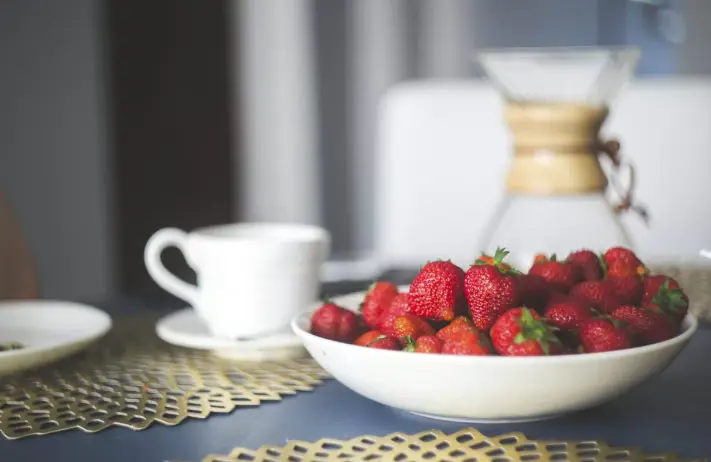
Did you enjoy the introduction? We strive to bring the best content so you are always informed. Keep an eye on our YouTube channel and blog. If you want, share this guide with your loved ones so they learn how easy it is to get started with this excellent gardening technique — anyone can enjoy the fruits of their labor quickly with ToDo Hydro.


